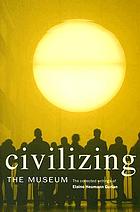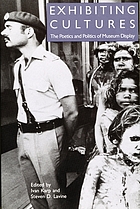
Though museums come in a variety of shapes and sizes—art, history, natural history, science, and children’s museums; botanical gardens and zoos; historic houses and memorial museums—those interested in museums must have a firm foundation in the history of museums and theoretical approaches to museology. Two good starting places are Museums in Motion: An Introduction to the History and Functions of Museums—first written and published in 1978 by Edward Alexander, and now in its third edition under the joint authorship of Edward Alexander, Mary Alexander, and Juilee Decker—and John Simmons’s Museums: A History. Alexander et al. examine the past and present of the museum landscape, with particular attention to institutions in the United States; Simmons examines museums worldwide, arguing that though they have changed over time to serve the needs of people across cultures and millennia, museums will remain important as a result of human curiosity. Five collections will be particularly useful in terms of scope, content, and framing. Museum Origins: Readings in Early Museum History and Philosophy, edited by Hugh Genoways and Mary Anne Andrei, offers historical writings about museums (their history, philosophy, and theory) from the ancient world through the twentieth century, with attention also paid to museum education and exhibition. The Emergence of the Modern Museum: An Anthology of Nineteenth-Century Sources, edited by Jonah Siegel, digs deeper into the formation of collections. Although Siegel focuses on the origins of the museum in Britain, the issues the writings reveal the contentious nature of nation building and the associated purposeful construction of knowledge.
Shifting from the historical to the contemporary, A Companion to Museum Studies, edited by Sharon Macdonald, is a multidisciplinary collection of essays by leading scholars who invoke representational critique as a means of expanding the approaches, empirical base, and framing of museum studies. In Grasping the World: The Idea of the Museum, edited by Donald Preziosi and Claire Farago, scholars from a number of fields (primarily philosophy, art history, and psychology) examine power and knowledge, narrative and memory, and psychoanalysis and history. Finally, Museum Studies: An Anthology of Contexts, edited by Bettina Messias Carbonell, combines the best of both worlds: it offers primary and secondary works of the past two hundred years, providing historical and contemporary analysis of topics, issues, and trends of the field while emphasizing inclusion and exclusion, globalization, interactive technologies, and other timely concerns.
Collected writings of iconic practitioners and educators situate the field of museum studies at particular moments. Key collections include The New Museum, a selection of writings by John Cotton Dana edited by William Peniston, and Civilizing the Museum: The Collected Writings of Elaine Heumann Gurian. As librarian of the Newark, NJ, Free Public Library, Dana established a “museum of museum experiments,” publishing his observations in 1917 and proclaiming the museum a community-focused, alive, and active space of entertainment, enlightenment, and education to fit the needs and aspirations of a community. In her collection, Gurian advocates for new museums, calling for museums to be relevant and community-focused by engaging in work that is thought provoking, dialogue-centered, and inclusive. Equally important, though not available in a contemporary edition, is G. Brown Goode’s Museum History and Museums of History, which is based on an 1888 address Goode (as assistant secretary of the National Museum at the Smithsonian) delivered to the American Historical Association. In it Goode looks at the origins of museums, starting in classical times, and positions history museums as critical to the construction of national narratives.
On the general history of American museums in particular, two key works are Steven Conn’s Museums and American Intellectual Life, 1876–1926, and Marjorie Schwarzer’s Riches, Rivals, and Radicals: 100 Years of Museums in America. Treating museums as sites of intellectual and cultural debate, Conn writes that the intellectual backbone of museums, coupled with the Victorian fascination with objects of all sorts, fostered a “bourgeois acquisitiveness” that begat a culture of consumption that persists even today. Schwarzer offers a readable, impeccably researched, and lavishly illustrated survey that explicates how American institutions have served as a prism of society.
Overviews of museum studies can be found in Kiersten Latham and John Simmons’s Foundations of Museum Studies: Evolving Systems of Knowledge and Museum Studies: Perspectives and Innovations, edited by Stephen Williams and Catharine Hawks. Latham and Simmons offer a theory-based introduction to museums and the discipline of museum studies; Williams and Hawks cover three areas: professionalism, academic programs, and challenges. Though some of the content in the latter is dated, the collection includes a piquant conversation on merging museum studies and library science as well as discussion of curriculum standards.
The philosophy and theory of museum studies is framed in four key works. In The New Museology, published in 1989, editor Peter Vergo emphasizes that whereas the “old” museology focused on methods, the “new” emphasizes the purposes of museums, marking a shift from what and how to why and to what end. Some two decades later, New Museum Theory and Practice, edited by Janet Marstine, presents more recent perspectives on the politics and ideologies of museum practice. Perhaps the most compelling essay in this collection is Margaret Lindauer’s on the critical museum visitor as one who is informed by theory and empowered “to effect change in the institution … [in] a new museum model that declares institutional purpose, acknowledges a point of view, provides cultural context, reveals contradiction, and inspires debate.” From Museum Critique to the Critical Museum, edited by Katarzyna Murawska-Muthesius and Piotr Piotrowski, theorizes the critical museum and examines ways of making museums critical (as supported by case studies). Finally, Museum Philosophy for the Twenty-First Century, edited by Hugh H. Genoways and comprising contributions from scholars trained both outside and within museum disciplines as well as museum professionals, looks at issues facing museums today and areas museums should pursue in the twenty-first century.
In Museums and the Public Sphere, Jennifer Barrett considers museum context and how it stages the way the public (or publics) is realized, invoked, and understood. In The Birth of the Museum: History, Theory, Politics, Tony Bennett examines the role of museums in Victorian society and, by extension, the legacy of their power, self-regulation, and exhibition narrative. Seeing the advent of the public museum as a “vehicle for the exercise of new forms of power,” Bennett demonstrates how museums construct, regulate, and exercise knowledge. In Civilizing Rituals: Inside Public Art Museums, Carol Duncan explores museums in the US and Europe, arguing that what people “see and do not see in art museums … is closely linked to larger questions about who constitutes the community and who defines its identity.” Museums and Memory, edited by Susan Crane, takes up similar threads, looking at museums as sites of interaction between personal and collective identities.
Offering perspective on “what museums have been and have become,” Hilde Hein’s The Museum in Transition: A Philosophical Perspective articulates the ways museums have shifted from object-centered institutions to narrative-centered spaces that emphasize experience. Put simply, museums must earn their keep, a point Stephen Weil also notes throughout his Making Museums Matter (2002). Weil goes so far as to list attributes of the good museum—efficiency, responsiveness, and accessibility—and asks museums to make a difference.
Editors Ivan Karp and Steven Lavine take up the politics of display and agency in Exhibiting Cultures: The Poetics and Politics of Museum Display, which includes essays by museum directors, curators, art historians, historians, anthropologists, and folklorists. In Destination Culture: Tourism, Museums, and Heritage, Barbara Kirshenblatt-Gimblett examines museums, world’s fairs, festivals, re-creations, memorials, and tourist attractions, looking at how meaning is made and foregrounded through objects, performers, and display. And in Museum Bodies: The Politics and Practices of Visiting and Viewing, Helen Rees Leahy looks at the shift away from the museum as collection to the museum as site for social and corporeal practices.
Kylie Message, in New Museums and the Making of Culture, positions museums as media that are “evolving as a cross-disciplinary, self-consciously political, and often avowedly self-reflexive institution.” Message argues that the new kind of museum that emerged in the late twentieth century was brought on by shifts in museum practice and cultural policy; appropriations of museums by scholars of cultural studies; and the changing relationship of the museum to the state and other bodies.
Also helpful in situating museums within the landscape of historic sites, memorials, national parks, and other constructions is Rodney Harrison’s Heritage: Critical Approaches. Harrison offers theoretical approaches and models for decision-making processes of relevance to spatial, temporal, and institutional concerns. Advocates for the object and its wonder enrich this discourse as well. Nicholas Thomas’s The Return of Curiosity: What Museums Are Good for in the 21st Century calls for a return to the wonder of collections for their capacity to stimulate curiosity and their potential to “inform and empower what is positive around museums in the present.”
 Civilizing the museum : the collected writings of Elaine Heumann Gurian by
Civilizing the museum : the collected writings of Elaine Heumann Gurian by  Exhibiting cultures : the poetics and politics of museum display by
Exhibiting cultures : the poetics and politics of museum display by